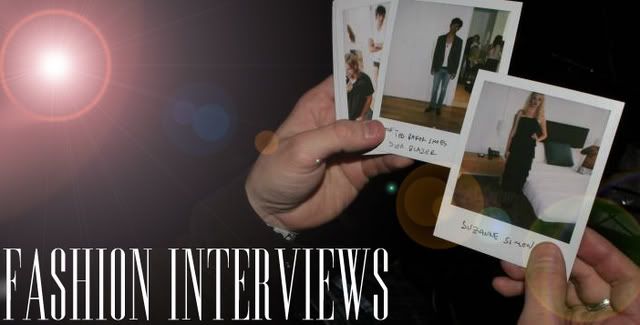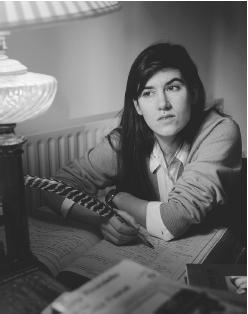
 WITH ARIANA SPEYER
WITH ARIANA SPEYER
Her clothes' louche look belies their intricacy. She designs her own textiles, working with factories in France, Italy, and Japan. After graduating from Saint Martins, Sharon Wauchob launched her own label in Paris in 1998. Ariana Speyer spoke with the designer at her atelier on Rue de Beauce in the third arrondissement.
ARIANA: After a childhood in rural Ireland, you ended up in London, the big city.
SHARON: I grew up on a livestock farm in the northwest of Ireland. My home was so remote, it felt closer to America than to London. But immigration is one thing the Irish are good at.
ARIANA: In London, you trained at Saint Martins, as did so many rising designers.
SHARON: Saint Martins was the most direct route to a fashion career that I could think of. And it was challenging to wrap my mind around London. I was so young, and had never been anywhere that came close to it. In the '90s, everything in London felt innovative and cutting edge.
ARIANA: Did you always know you wanted to design clothes?
SHARON: For me, it was a form of escapism rather than a love of clothes or sewing. I would spend hours poring over the boring clothes catalogs we had around the house. I was a freak!
ARIANA: How did you end up working here in Paris?
SHARON: Right after I graduated from Saint Martins in 1993, I got a job with the Japanese designer Koji Tatsuno, who moved his studio to Paris later that year. At the time, there wasn't much happening here, but we had a feeling that it was going to become more exciting.
ARIANA: And did that happen?
SHARON: Well, at first the pace seemed slower than in London. The fashion industry here projects an exterior calm. But there's a lot of life bubbling under the surface — this business requires a great deal of dedication and speed.
ARIANA: After working with Koji, you became an in-house designer at Louis Vuitton in 1997.
SHARON: I'm glad I experienced the mechanics of a big company. It gave me a totally different insight into the industry. It was a creative time for me — I was there at a pivotal moment.
ARIANA: Vuitton was going through a major transformation. Marc Jacobs had just arrived. They were launching the monogram as a fashion symbol.
SHARON: I worked on the monogram — I was able to be quite inventive. I enjoy developing new concepts and experimenting with new materials. When I worked with Koji, we developed our own textiles.
ARIANA: The Japanese are known to be extremely resourceful when it comes to fabrics.
SHARON: They've had to be. Before the country opened up to the West, they weren't importing goods from other countries. The Japanese didn't have the raw materials necessary to make European-quality fabrics, so they evolved their own processes. Even now, the way they fabricate yarn is different than in Europe. More recently, they've focused their energy on developing synthetic materials with great success. I still use the hands-on experience I gained creating textiles with Koji in my present business. I always go to my factories to understand how their processes work.
ARIANA: Where do you produce your clothes?
SHARON: The garments are usually produced in France, but I'll go anywhere to find the fabrics or processes that I need. I've purchased lace from a factory in France and taken it to another factory in Italy to have it laminated.
ARIANA: European factories usually specialize in just one kind of fabric. It must be a challenge if you want to experiment.
SHARON: Exactly. Recently, I wanted to create a brocade look on a jacket. I took Irish tweed and French lace to a factory in Japan where they used an old Japanese needle-punching process to pull the tweed through the lace. The two fabrics fused together to create the effect that I wanted.
ARIANA: You really take advantage of the expertise and specialization that exists in the textile industry.
SHARON: When I go to a new factory, I hope I'll meet someone who is willing to help me implement my vision. Chance plays a big role in this whole process. That's why the designer has to be involved in every stage of production. There are a lot of manufacturing techniques that designers don't tap into — simply because they aren't working closely with their producers.
ARIANA: Do you ever meet resistance from your manufacturers?
SHARON: I think they're usually quite relieved by the level of my involvement, actually. My partner, Josh, and I speak with our factories every day. We simply can't afford to be detached from the production process if we want our business to work.
ARIANA: Independent designers have to juggle so many tasks on very tight deadlines.
SHARON: My mind is always spinning. Fashion is schizophrenic — it's artistic and practical at the same time. I think that's as real as you can get.
ARIANA: Do you sketch as part of your design process?
SHARON: I sketch as a way to archive my ideas, but I don't generally believe in working in two dimensions. We often do things simultaneously that are normally done in sequence, like finishing and detailing. Last season, when we made a relaxed silk shirt, we began with a detail, the large leather cuffs that wrap around the arms. That detail determined the shape of the whole garment.
ARIANA: Do you work season to season or do you have an overarching vision for the label?
SHARON: We're beginning to focus on the long-term. I used to resist the retro look, but I realized people have always been drawn to familiarity in fashion, so I'm working on ways to use it. Last season we produced hand-painted suede jackets, which are very 1970s. The design evoked a sense of irony, but it was also sophisticated and feminine.
ARIANA: I think I've seen that piece. Is it the suede jacket with chiffon panels sewn into the back?
SHARON: Yes. We mixed suede and leather with silk chiffon. I like playing around with different fabric weights within the same garment.
ARIANA: Some of your pieces can also be worn several different ways.
SHARON: I design for women who like to mix things up a bit. For instance, if I go away for a week, I don't bring different clothes for day, evening, and business. My clothes can be reinterpreted and adapted to different situations. We've made hoods and collars that you can wear like little jackets, or wear over other jackets as accessories.
ARIANA: Does being Irish influence your work?
SHARON: It has certainly affected my color sensibility. Where I come from, the light is flat, so your eye becomes accustomed to very subtle tones. At the beginning of my career, working with contrast was difficult, but I've tackled what I was scared of in terms of colors. Now I'm quite comfortable using both subtle and intense shades.
ARIANA: Do you go back to Ireland a lot?
SHARON: Yes. I still have ties there. My family has been there for two hundred years — in the same house, actually.
ARIANA: Why do you think there are so few Irish designers?
SHARON: It's surprising when you consider that there is so much music, so much film, so much theater. But fashion differs in one respect — it's an industrial process, and Ireland just doesn't have the manufacturing infrastructure.
ARIANA: I hear Dublin's got a great artistic and social scene.
SHARON: There's such a strong youth culture there. Josh says that whenever he's in Dublin, it always feels like school just got out. They're not scared of creativity. They embrace it.
(Credit: index magazine)
(Photo credit:www.rte.ie/tv)

![]() WITH ARIANA SPEYER
WITH ARIANA SPEYER




